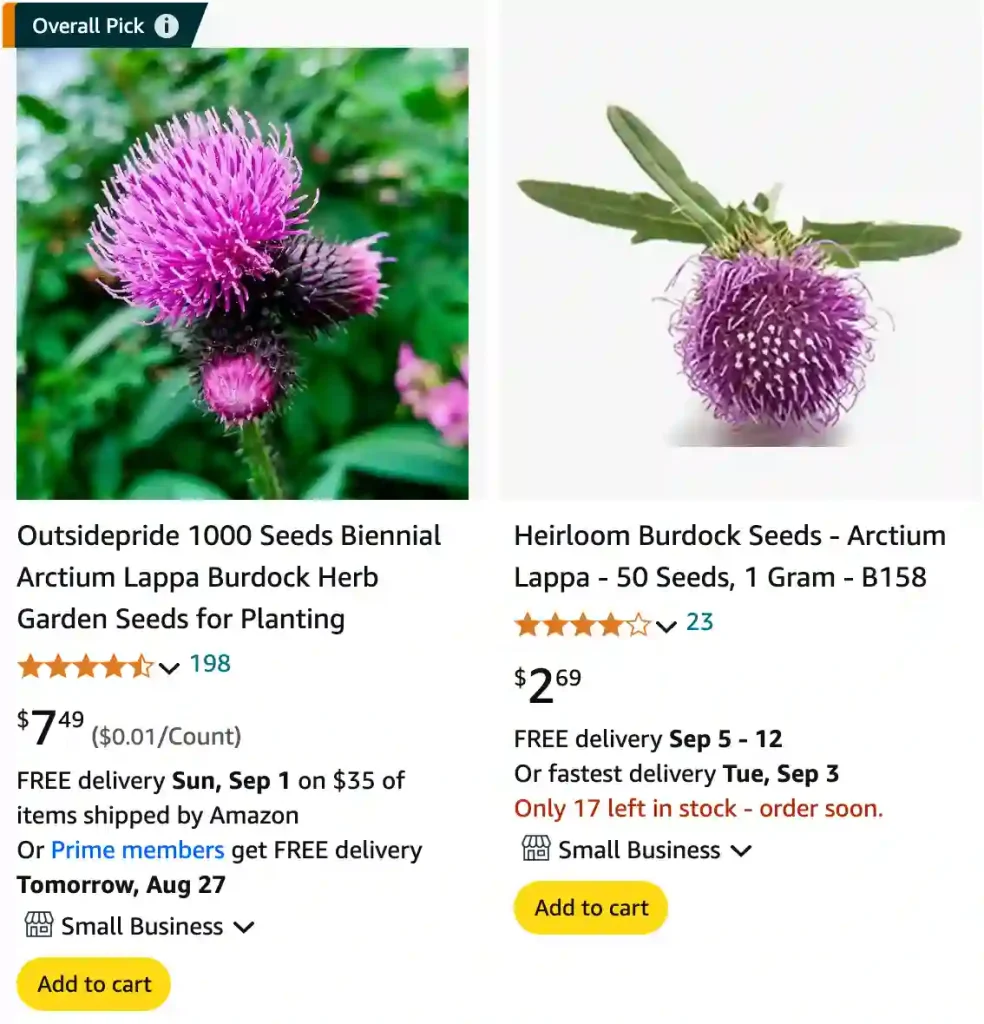
What is Arctium Lappa?
Arctium Lappa, commonly known as Burdock, is a biennial herb that has been used in traditional medicine for centuries. It belongs to the Asteraceae family and is characterized by its large, heart-shaped leaves and distinctive, spiky flower heads. The plant grows up to 9 feet tall and produces purple or pink flowers that eventually turn into burrs, which are infamous for sticking to clothing and fur. The root of Arctium Lappa is particularly valued for its medicinal properties and has been used in various cultures to treat a range of ailments.
52 Species in Genus Arctium
What Country Does Arctium Lappa Come From?
Arctium Lappa is native to Europe and Asia. It has a long history of use in these regions, where it was often found growing wild in temperate climates. Over time, it spread to other parts of the world, including North America, where it is now considered an invasive species in some areas due to its aggressive growth and ability to outcompete native plants.
How to Grow Arctium Lappa?
Growing Arctium Lappa can be both rewarding and challenging. Here’s a step-by-step guide to help you get started:
- Choose the Right Location: Burdock thrives in full sun to partial shade and prefers well-drained soil. It can tolerate a range of soil types but grows best in loamy soil with a pH of 6.0 to 7.0.
- Planting: You can start Arctium Lappa from seeds. Sow the seeds directly into the soil in early spring or late fall. If you’re starting indoors, sow the seeds in pots 8-10 weeks before the last frost. Plant seeds about 1/4 inch deep and keep them moist until germination.
- Spacing: Space the plants about 12-18 inches apart to allow for their large size. Burdock can grow quite tall and wide, so ensure there is enough room for it to spread.
- Care: Water the plants regularly, especially during dry periods. Mulching around the base can help retain moisture and suppress weeds. While Burdock is relatively low-maintenance, it benefits from occasional fertilization, particularly in poor soils.
How to Care for Arctium Lappa?
Caring for Arctium Lappa involves regular maintenance to ensure healthy growth. Here are some tips:
- Watering: Keep the soil consistently moist but not waterlogged. Overwatering can lead to root rot, while underwatering can stunt growth.
- Fertilizing: Apply a balanced fertilizer once or twice during the growing season to promote vigorous growth.
- Pruning: Remove spent flowers and burrs to prevent the plant from spreading uncontrollably. Cutting back the plant after flowering can also help manage its size.
How to Propagate Arctium Lappa?
Propagating Arctium Lappa is primarily done through seeds. Here’s a simple method to propagate it:
- Harvest Seeds: Collect the seeds from mature burrs in late summer or early fall. Allow them to dry thoroughly before storing.
- Sow Seeds: Sow the seeds in prepared soil, either directly in the ground or in pots. Keep the soil moist until the seeds germinate.
- Transplant: Once the seedlings are large enough to handle and have at least two sets of true leaves, transplant them to their final location.
What is Arctium Lappa Root Extract?
Arctium Lappa root extract is derived from the root of the Burdock plant. It is known for its potent medicinal properties and is commonly used in herbal remedies. The extract contains a range of bioactive compounds, including flavonoids, phenolic acids, and polysaccharides, which contribute to its health benefits.
What is Arctium Lappa Used For?
Arctium Lappa has a variety of uses, particularly in traditional medicine. Here are some common applications:
- Detoxification: The root is known for its detoxifying properties, helping to cleanse the liver and kidneys.
- Skin Health: It is used topically in creams and ointments to treat acne, eczema, and psoriasis due to its anti-inflammatory and antimicrobial properties.
- Digestive Health: Arctium Lappa root is used to aid digestion and alleviate gastrointestinal issues like bloating and constipation.
Can You Grow Arctium Lappa Indoors?
While it’s possible to grow Arctium Lappa indoors, it requires a significant amount of space due to its size. It needs a large pot and a well-lit location. Additionally, indoor growing may limit the plant’s ability to reach its full height and potential.
Is Arctium Lappa Toxic?
Arctium Lappa is generally considered non-toxic and safe for most people when used appropriately. However, if you have allergies to plants in the Asteraceae family or are pregnant, consult with a healthcare professional before using it medicinally.
Benefits of Arctium Lappa
Arctium Lappa offers several benefits, including:
- Antioxidant Properties: The plant is rich in antioxidants, which help to combat oxidative stress and reduce inflammation.
- Immune Support: It can boost the immune system, helping to ward off infections and illnesses.
- Skin Health: Its anti-inflammatory properties make it beneficial for various skin conditions.
Common Problems with Arctium Lappa
Despite its benefits, Arctium Lappa can present some issues:
- Invasiveness: It can spread rapidly and become invasive in some regions, outcompeting native plants.
- Pests: The plant can attract pests like aphids and caterpillars, which may require management.
Arctium Lappa vs. Minus
When comparing Arctium Lappa with Arctium Minus (a similar species), the key differences lie in their growth habits and appearance. Arctium Minus is typically smaller, with more slender leaves and a less aggressive growth pattern compared to the larger, more robust Arctium Lappa. Both have similar medicinal uses, but their size and spread can influence how they are managed in gardens.
In summary, Arctium Lappa is a fascinating plant with a rich history of use in traditional medicine. Whether you’re growing it for its medicinal properties or just as an interesting addition to your garden, understanding how to care for it and manage its growth can make all the difference.
If i die, water my plants!



